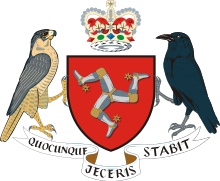Lord of man
Lord of Mann or Lord of Man ( Manx : Çhiarn Vannin ) is the title of Elizabeth II , the monarch of the United Kingdom , as Lord Proprietor and Head of State of the Isle of Man . The Latin title is "Dominus Manniae".
Notation
The full name of the island is only written with an "n" in English today. From the official side, the title is spelled with an “n” as well as with two “n”.
history
The Isle of Man came under Scottish rule with the Peace of Perth in 1266 , after previously being part of the Norwegian Kingdom of the Isles . After the death of the Scottish King Alexander III. In 1285, rule over the Isle of Man came in the power struggle for the Scottish crown under the influence of the English kings Edward I and after him Edward II , who enfeoffed various nobles with the Lordship of Man from 1290. Sovereignty over the island changed back to the kings of Scotland on various occasions, for example from 1313 to 1333, when the Earls of Moray were enfeoffed with it. After the decisive battle at Halidon Hill in 1333, Edward III. (England) the island finally out of Scottish suzerainty. From then on, the English kings made various English nobles Lords of Man. The rule of the Stanley family, Earls of Derby , lasted particularly long and lasted for centuries with a few interruptions since the enfeoffment of Henry IV in 1405. During the reign of Henry VIII , Thomas III. Stanley the title of King of Mann to Lord of Mann ; Formally, the island had previously been considered a separate kingdom. The rule changed in the 17th century from the Stanleys to the Dukes of Atholl , but the British crown regained more and more regalia until it regained complete sovereignty over the island in 1765. From then on, the British monarch no longer entrusted a nobleman with the title of Lord of Man, but kept this rule in his own hands, presumably to better control the widespread smuggling on the island, so that George III. was the first Lord of Man in personal union with the British Crown. The British monarchs have held this title to this day and have the island administered by lieutenant governors.
Usage today
Regardless of gender, the title today is "Lord"; Queen Victoria , however, still ruled as the "Lady of Mann".
Correctly, the title cannot be used on its own. The Lord of Mann (and formerly King of Man) is feudal to the Crown of the United Kingdom ( Great Britain before 1801 and England before 1707 ) and is sovereign only through the personal union with the British Crown. The formal toast on the Isle of Man is therefore made to The Queen, Lord of Mann .
supporting documents
- ^ Tynwald of Today. ( Memento from June 9, 2010 in the Internet Archive ) In: Tynwald - The Parliament of the Isle of Man. Archived version of June 9, 2010; Isle of Man. In: Royal.gov.uk , accessed May 20, 2015.
- ^ Isle of Man Government: Tynwald Day. (No longer available online.) In: Isle of Man Government website. Archived from the original on August 19, 2004 ; Retrieved January 14, 2009 . Info: The archive link was inserted automatically and has not yet been checked. Please check the original and archive link according to the instructions and then remove this notice.
- ^ The Queen visits the Isle of Man. In: Royal Insight (on the website of the British royal family). Retrieved January 14, 2009 .
- ↑ For the history, see James Robinson: History. ( Memento of the original from April 24, 2015 in the Internet Archive ) Info: The archive link was inserted automatically and has not yet been checked. Please check the original and archive link according to the instructions and then remove this notice. In: Isle of Man Courts of Justice. 2009, updated October 16, 2014.
- ^ Isle of Man. In: Royal.gov.uk .
